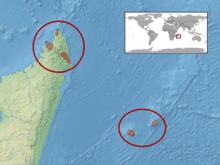Great Madagascar day gecko
| Great Madagascar day gecko | ||||||||||||
|---|---|---|---|---|---|---|---|---|---|---|---|---|

Large Madagascar day gecko in the Stuttgart Wilhelma |
||||||||||||
| Systematics | ||||||||||||
|
||||||||||||
| Scientific name | ||||||||||||
| Phelsuma grandis | ||||||||||||
| Gray , 1870 |
The great Madagascar day gecko ( Phelsuma grandis ) is a separate species within the genus of day geckos ( Phelsuma ). Until 2007 the species was considered a subspecies of Phelsuma madagascariensis .
description
The great Madagascar day gecko is one of the largest geckos, along with the stripe day gecko ( Phelsuma standingi ). It has a total length of up to 30 cm and a head-torso length of 15 cm. The basic color is bright green with red stripes. This is clearly pronounced in the youth color and can disappear completely in the adult animal, so that almost pure green specimens are found. Only a red stripe from the nose to the eye is always present. The throat and belly are white to light gray in color.
Differences between the sexes
In general, the males are larger, have a more massive head and are usually more richly colored. The average length of a male is 25-27 cm, the typical female is about 21-24 cm long. However, these are only vague indications. The only reliable differentiation besides a genetic examination are the femoral pores (thigh pores ), which are significantly more pronounced in an adult male and have a yellowish color, especially in older males.
distribution
The great Madagascar day gecko occurs between Antsiranana and Antonibe in northern Madagascar and on the island of Nosy Be . All of the specimens that have been discovered have so far been close to the coast and rarely more than 200 m above sea level. This gecko was introduced to Mauritius and the Florida Keys .
nutrition
In addition to animal food (insects, spiders, snails, etc.), the gecko also feeds on ripe to overripe fruits, nectar and pollen. These should also be fed in the terrarium keeping, baby porridge and fruit quark or yoghurt have proven themselves as alternatives.
Terrariums

The species is often kept in terrariums . In Germany it is bred so successfully that it was exempted from the reporting requirement in 2005 as a subspecies of Ph. Madagascariensis in accordance with Annex 5 to Section 7 (2) of the Federal Species Protection Ordinance; furthermore, the lawful acquisition and the origin must be proven.
An appropriately sized terrarium is a prerequisite for keeping these large day geckos in a species-appropriate manner. The gecko should only be fed moderately as it tends to become fat. In the long run, it can only be kept in pairs.
literature
- Gerhard Hallmann, Jens Krüger, Gerd Trautmann: Fascinating day geckos. The genus Phelsuma. 2nd, revised and expanded edition. Natur-und-Tier-Verlag, Münster 2008, ISBN 978-3-86659-059-5 .
Web links
- Phelsuma grandis in The Reptile Database
- Phelsuma grandis on the website of the Phelsuma interest group (IG Phelsuma)
- Phelsuma grandis inthe IUCN 2013 Red List of Threatened Species . Posted by: Ratsoavina, F., Glaw, F. & Rakotondrazafy, NA, 2001. Retrieved January 31, 2014.
Individual evidence
-
↑ Quoted from Hallmann et al., P. 115:
- 1970 Phelsuma madagascariensis grandis MERTENS, Senckenb. biol., Frankfurt / M., 51 (1/2): 5, fig. 5.6.
- 2007 Phelsuma grandis RAXWORTHY, INGRAM, RABIBISOA & PEARSON, Syst. Biol. 56 (6): 917, Fig. 5c.
- ↑ a b c Gerhard Hallmann and others: Fascinating day geckos. 2008, ISBN 3-8665-9059-8 , esp. Pp. 115-118.
- ↑ Gerhard Hallmann: The possible food spectrum of the geckon genus Phelsuma . In: IG Phelsuma (ed.): IGP circular 4/98. Retrieved January 28, 2013.
- ↑ See protection status and statutory provisions . IG Phelsuma, accessed July 8, 2016.
